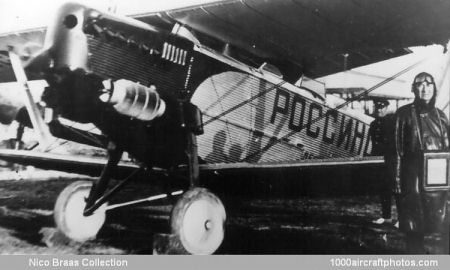11/30/2009. In July 1924 the military in the USSR accepted the Kolchug corrugated duralumin construction for military aircraft. The department of aviation authorized Tupolev to build a single-engined reconnaissance aircraft with the designation ANT-3 (military designation R-3.
Of conventional single-bay sesquiplane layout, the 236.7 sq.ft (24,5 sq.m) two-spar upper wing was placed very close to fuselage, the 134.5 sq.ft (12,5 sq.m) single spar lower was fitted to the fuselage bottom, while Y-type interplane struts of Kolchug sheet wrapped to streamline form linked all spars.
The first aircraft was completed as a passenger aircraft with rear cockpit having forward-facing seat and windscreen for passenger or mechanic, and was powered by a 400 hp Liberty 12 twelve-cylinder liquid-cooled V-engine, cooled by two Lamblin radiators. Registered RR-SOV, the aircraft was first flown by V.N. Filippov in August 1925. Following successful factory tests series production was initiated in December 1925.
Re-engined with a 450 hp Napier Lion engine and redesignated R-3NL, the prototype became the first Soviet aircraft seen outside the USSR, when pilot M.M. Gromov and mechanic Ye.V. Radzevich flew the ca. 3,915 mls (6,300 km) propaganda tour Moscow-Königsberg (presently Kaliningrad)-Berlin-Paris-Rome-Vienna-Prague-Warsaw-Moscow, in 34 hr 15 min flying time between August 30 and September 2, 1926.
The Lion-engined aircraft was superior to the Liberty-engined type, however, due to financial and other reasons the Liberty engine was placed in the first twelve aircraft, followed by eighteen aircraft fitted with the Soviet version of the Liberty 12, the M-5. The first production aircraft, a civil ANT-3, eventually flown in June 1927, was prepared for even longer propaganda flights. Registered
RR-INT and crewed by pilot S.A. Shestakov and mechanic D.V. Fufayev it was flown from Moscow to Tokyo in 153 flying hours between August 20 and September 1, 1927.
In 1926 the 450 hp Lorraine-Dietrich engine was obtained and fitted in 79 military aircraft, designated R-3LD. These were fitted twin 0.3 in (7.62 mm) machine guns on a ring in the rear cockpit, while ten 110 lb (50 kg) FAB-50 bombs could be carried on racks below fuselage.
One aircraft was experimentally fitted with a 730 hp BMW VIz engine, showing even better performance, but reached limits of structural strength. Another aircraft was converted to a PS-3 transport for use by Aeroflot.
Pictured in front of the aircraft is the holder of the first Russian pilot license Boris I. Rossinskii, named 'Grandfather of Russian aviation' by Lenin on May 1, 1918.
